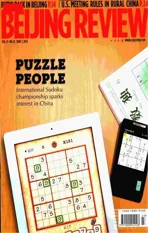THIS WEEK
2012-12-23
THIS WEEK
OPINION
Avoiding Shortsighted Policies
Amid a complicated domestic and international economic front, maintaining steady economic growth has become key for China’s macrocontrol efforts. During a recent inspection tour in central China’s Hubei Province, Chinese Premier Wen Jiabao said more priority should be given to promoting steady growth. In the meantime, concerned authorities, including the National Development and Reform Commission, Ministry of Finance, Ministry of Commerce and Ministry of Industry and Information Technology, are preparing for further slowdown of China’s GDP growth.
After several rounds of macro-control since the global fi nancial crisis began, the keynote of China’s macro-control has once again bounced back to “growth.” More priority for maintaining steady growth re fl ects policymakers’ deep concern to the economic situation and growth prospect.
China’s economic growth faces internal and external pressure: sluggish domestic demand and weak external demand. Investment and consumption have both fallen, leaving both supply and demand worse off than before. Enterprises’profit margin, fiscal revenue, industrial output, export orders and housing prices have all slipped. Worse still, three sensitive barometers for evaluating economic growth—electric power consumption, industrial value-added output and bank loans—have nosedived, showing dwindling momentum for GDP growth. Taking the industrial value-added output in April for instance, it increased 9.3 percent year on year, 2.6 percentage points lower than the growth in March. From the past we can see that the 12-percent growth of industrial value-added output corresponds with 8-percent GDP growth, while the fi gure in April indicated GDP growth may fall to 7.5 percent in the second quarter. The accelerated slowdown of GDP growth has come close to the bottom line for policymakers.
During the past four years, world economy seems to have returned to its pre-crisis level. However, what we are facing is far beyond a cyclical crisis but is a structural crisis since the economic globalization, featuring a structural debt crisis of developed countries after long-term accumulation, the unbalanced development between saving countries and spending countries and a crisis stemming from the old growth pattern of the world.Those problems will defy all counter-cyclical efforts and policies.
China is trapped in a “blank phase” during its transformation of growth pattern. In the mid- and long-term, the total factor productivity has gradually decelerated and the market is shrinking due to insufficient external demand.Moreover, China’s traditional low cost advantage is disappearing due to the rising labor cost,the appreciation of the yuan and the restriction from limited resources. The previous fast growth model, backed up by heavy industry, export and investment, can’t continue, but new growth incentives, such as domestic demand and emerging industries, haven’t caught up. Slowdown of economic growth caused by this “blank phase” will inevitably cause China some pain. In order to maintain steady growth and avoid further slowdown, policymakers are apt to choose stimulus methods that are bene fi cial for short-term growth targets. Thus, the economy will overly depend on stimulus policies, which will defer the formation of indigenous momentum of economic development. This might be the biggest contradiction facing China’s macro-economy.
Therefore, how to give short-term policies sustainable effects? How to avoid side effects of stimulus policies? These are testing the wisdom of policymakers. Judging from the current condition in the country, domestic consumption is not enough. It’s okay to keep a certain amount of investment, but where should the investment go?China used to put too much emphasis on “hard”investment, such as infrastructure and machinery equipment, and overlook “soft” investment, such as research and development, technological innovation and education.
We do need to maintain steady growth, but should also improve the quality of long-term economic growth. It’s the only way to have a virtuous circle for China’s economy.
THE MARKETS
Promoting Exports
China Jiangsu Export Commodities Exhibition 2012 opened in Osaka, western Japan, on May 22, with more than 200 fi rms from the Chinese coastal province attending the event to promote exports to Japan.
The three-day event, held in MyDome Osaka, a major exhibition hall in central Osaka, is the largest ever launched in Japan,covering an area of 5,000 square meters, with 280 booths on three floors. A wide range of products such as shoes, clothes, home fabrics and daily commodities are on display.
“The number of exhibitors this year almost doubled compared with last year, when many companies in the province withdrew over fear of radiation in the wake of the Fukushima nuclear accident,” said Li Lei, an official of the Jiangsu delegation at a press conference. “We hope the fair will further boost business opportunities between Jiangsu and Osaka.”
Mobile Service
China Telecom, the nation’s largest fi xed-line operator, announced the launch of its mobile phone business in the UK on May 22, making China Telecom the fi rst Chinese mobile virtual network operator to be launched outside the country.
With around-the-clock Chinese and English language customer services, designed to provide information on transport routes and tourism services, the new service, called CTExcelbiz, hopes to attract Chinese residents and visitors to the UK.
“This is the fi rst time that we’re selling a product directly on the consumer market, because our past customers were all companies.But we are fully prepared for this challenge,”said Ou Yan, Managing Director of China Telecom Europe. “The launch was also linked to the London Olympic Games this summer,when 170,000 Chinese tourists are expected to visit Britain.”
If CTExcelbiz proves successful, China Telecom will launch similar services in other European countries, such as France and Germany.
This is an edited excerpt of an article by Zhang Monan,an associate researcher with the State Information Center, published in theEconomic Information Daily
